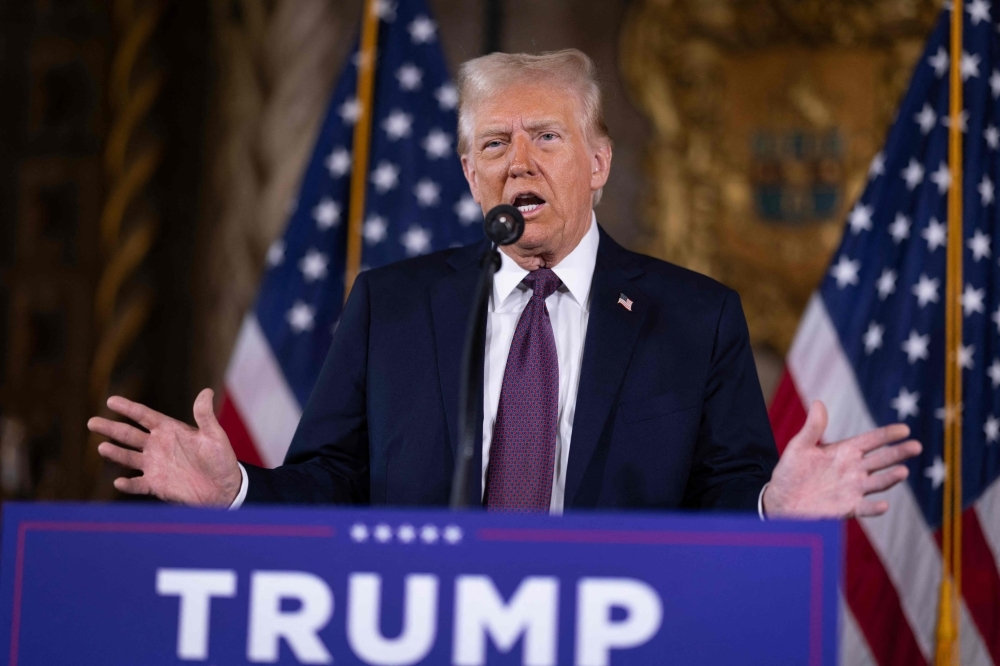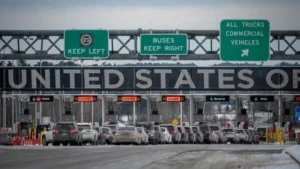Donald Trump’s Provocative, Often Confusing, US Foreign Policy Is Back

Donald Trump’s Provocative , Often Confusing, US Foreign Policy Is Back –Donald Trump said he would not rule out using military or economic coercion to acquire Greenland and the Panama Canal, and vowed to bring Canada to heel.
Donald Trump’s Provocative Palm Beach, United States:
In a provocative and headline-grabbing Tuesday speech on his territorial ambitions for the United States, incoming US leader Donald Trump was heavy on intimidation but light on details — leaving many wondering how seriously the comments should be taken.
In a rambling press conference at his Mar-a-Lago estate in Florida, Trump said he would not rule out using military or economic coercion to acquire Greenland and the Panama Canal, and vowed to bring Canada to heel.
He called the border with the United States’ northern neighbor an “artificially drawn line,” and promised to rename the Gulf of Mexico the “Gulf of America.”
The free-wheeling press conference brought to mind the Republican’s many bombastic and provocative statements from his first term, when he said he would encourage Russia to “do whatever the hell they want” to NATO allies and called North Korea’s leader a “rocketman on a suicide mission.”

Donald Trump promised to rename the Gulf of Mexico the “Gulf of America.”
Threatening Panama, Greenland
On the strategic Panama Canal, which was built by the United States and then handed over to the Central American country 25 years ago, Trump said the waterway was “vital to our country.”
“Look, the Panama Canal is vital to our country. It’s being operated by China — China! — and we gave the Panama Canal to Panama, we didn’t give it to China,” Trump said. “And they’ve abused it, they’ve abused that gift.”
Panama has repeatedly denied Trump’s allegations that China has been given a role in running the canal or is given preferential rates to use it.
As for Greenland, an autonomous territory of longtime US ally Denmark, Trump said: “We need Greenland for national security purposes.”
Canada will also soon be brought into the fold, Trump promised.
“You get rid of that artificially drawn line, and you take a look at what that looks like, and it would also be much better for national security,” Trump said.
Familiar themes
While Donald Trump’s fixation on the Panama Canal is relatively new, his interest in Greenland is not: he had already raised the idea of buying the island during his first term, drawing a sharp refusal from local authorities.
His son, Donald Jr., arrived in Denmark on a private trip on Tuesday.
Trump did, however, rule out using military force against Canada, which was thrown into political turmoil Monday when Prime Minister Justin Trudeau announced his plans to resign.
Trump threatened to use “economic force” against Ottawa, after suggesting that Canada should become the 51st US state.
Trudeau’s reaction: “There isn’t a snowball’s chance in hell that Canada would become part of the United States.”
His government is, however, preparing for the possibility of Trump following through on his threatened 25-percent tariffs on Canadian imports.
During his first term, Republican billionaire Trump frequently accused US allies — particularly NATO — of using the partnership and demanded they pay up.
It remained unclear whether Trump, whose inauguration will take place on January 20, was seriously considering expanding US territory, including by military force, or whether such sensational statements were merely a bargaining tactic to obtain economic or political concessions.
President-elect Donald Trump declined on Tuesday to rule out military or economic action as part of his avowed desire to have the U.S. take back control of the Panama Canal and acquire the Danish territory of Greenland.
He reiterated his interest in making Canada into a U.S. state and criticized American spending on Canadian goods and military support for Canada, one of the country’s closest allies.
Three main questions seem to underpin these debates. First, what is the Trump doctrine or Trump’s “grand strategy”, if any? Second, does Trump’s foreign policy strategy stem from any US historical tradition? Third, what are the risks of Trump’s foreign policy decision-making?
Is there a Trump’s “grand strategy”?
According to Robert Art’s classical definition, “‘grand strategy’ deals with the full range of goals that a state should seek, but it concentrates primarily on how the military instrument should be employed to achieve them. It prescribes how a nation should wield its military instrument to realize its foreign policy goals.” Posen and Ross underline that a well-defined and coherent “grand strategy” is one that identifies clearly: 1) the US interests and objectives; 2) the threats to those interests and objectives; 3) the appropriate strategic responses to those threats; and 4) the principles that should guide the development of US policy and strategy.
Accordingly, a “grand strategy” is often perceived as a roadmap that contains a vision for the US role in the world and thus sets up US most important foreign policy goals as well as the most effective instruments for achieving these goals. Moreover, grand strategies and foreign policy doctrines are forward-looking, prescriptive and evolutionary, and are often formed in response to crises, which create very specific challenges or threats to American national interests.
That is the case of some clearly defined doctrines, such as the Bush doctrine (formed in response to 9/11 terrorist attacks), the Reagan doctrine (formed to allow the US to stand up to the Soviet Union expansion by supporting anti-Communist guerillas in all parts of the world) or the Truman doctrine (the famous strategy of containment). It is also important to note that a number of official documents, namely National Security Strategies, National Military Strategies, Quadrennial Defense Reviews and Defense Strategic Guidance, issued by the President, the Department of State or the Department of Defense, are at the disposal of each administration to lay down its grand strategy.
Looking at the Trump administration which, even after its 100 first days in office, continues to function chaotically, some analysts, like Richard Haass, contend that not much of a “grand strategy” for establishing a new world order is to be found so far. Surprisingly enough, this position is shared by some White House officials like Mike Dubke, Trump’s former communications director, who declared at a formal meeting that “There is no Trump doctrine” before being corrected by another Trump staffer that “America First is the Trump doctrine.” Commentators argue that this highly improvisational and situational approach to foreign policy reflects the tensions inside the White House between the “globalists” and the “nationalists. The former are represented by Trump’s mainstream foreign policy advisers including his daughter Ivanka (hired as an unpaid government employee), his influential son-of-law Jared Kushner (senior advisor), Chief of staff Reince Priebus, National Security Council Director H. R. McMaster, Defense Secretary James Mattis, Secretary of State Rex Tillerson, while the latter include personalities like the far-right political strategist Steve Bannon.
Indeed, one could hardly disagree that Trump’s foreign policy statements are full of erratic, confusing and controversial ideas. This, added to his foreign policy gaffes, and his impulsive and undiplomatic decision-making and communication style, makes it difficult to see a clear vision to guide Trump’s strategy in foreign policy. Nevertheless, if one applies Posen and Ross’ conceptual framework of “grand strategy” to Trump’s foreign policy, one will be astonished to find out that the majority of components–1) US vital interests and objectives; 2) threats for these interests; 3) strategic responses to threats; and 4) guidelines for US foreign policy –, for building a grand strategy are actually present. On 17 April 2016, then candidate Trump delivered a speech at an event hosted by The National Interest review, which could be considered as the cornerstone of his foreign policy. Indeed, the majority of his ideas first presented in a coherent way in this speech can be found in other discourses held by President-elect Trump, such as his Inaugural Address or his speech at the NATO Summit in Brussels in May 2017.
In the second place, Trump’s strategy is also grounded on the idea according to which doing foreign policy is like running a business. In this light, applying deal-making to diplomacy and negotiations is considered crucial in order to obtain the best possible deal for America – “If we can’t make a good deal for America, then we will quickly walk from the table.” Consequently, Trump’s foreign policy strategy stems from a “zero-sum” approach to global affairs seen as “a game of winners and losers, not an exchange that generates mutual gains.” Additionally, this approach “entails an explicit rejection of America’s positive-sum, internationalist project, and a reversion to more narrowly nationalistic policies that carry distinct echoes of the 1930s and even before.”
Drawing on Posen and Ross’ conceptual framework of “grand strategy”, the above-made analysis reveals that President Trump actually has a grand strategy to the extent that he has defined all components: 1) a clear nationalist and sovereigntist vision of the US role in global affairs, which is narrowly focused on US interests and material gains, and no longer positions America as guarantor of the liberal world order; 2) the main threats the US has to face, namely Radical Islam and terrorism, “unfair trade deals” and entangling alliances, and illegal immigration; 3) the main instrument to defend US security and economy, i.e. military strength, when necessary, and “America First” pragmatic deal-making, even in diplomacy.
Consequently, the real question to be asked is not: Is there a Trump’s grand strategy? Rather, it should be: Isn’t Trump’s “America First” grand strategy anti-American in the sense that it is at odds with the US post-WWII foreign policy tradition grounded on the US-led liberal internationalist project? As Thomas Wright underlines, “One of the most common misconceptions about Donald Trump is that he is opportunistic and makes up his views as he goes along. But a careful reading of some of Trump’s statements over three decades shows that he has a remarkably coherent and consistent worldview […]. Many of these views would have found favor in pre-World War II – and even, in some cases, 19th century-America.” Accordingly, we argue that Trump’s “America First” grand strategy is deeply anchored in the US foreign policy history and can be best understood as a resurgence of the 19th-century foreign policy tradition, which the renowned historian Walter Russell Mead has described as the Jacksonian tradition.
With Thanks Reference to:https://shs.cairn.info/revue-l-europe-en-formation-2017-1-page-33?lang=fr And https://www.ndtv.com/world-news/donald-trumps-provocative-often-confusing-us-foreign-policy-is-back-7425146







